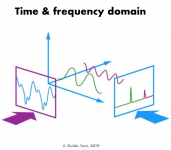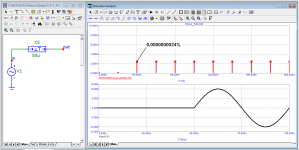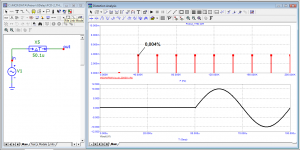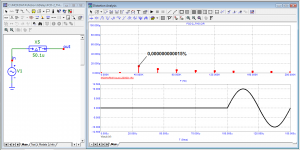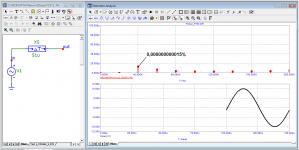Music played through a system with 50kHz BW should be possible to be described by 50 kHz BW limited sinus shapes.
//
//
Let's stick to audio please, you keep saying music isn't made up of sine waves, prove it, don't waste your time, you can't.This is true.
But you need an infinite bandwidth to do so.
100 THz is still infinely short of infinite bandwidth. And very few amps does a very good job above a few Mhz.
The nonlinear physics of musical instruments - IOPscience
I have already posted this in a previous post.
Nonlinear system - Wikipedia
You keep on mentioning FFT. If you don´t want to use infinity or an for us pretty good aproximation of say 100 THz then please don´t keep mentioning FFT.
From:
Square wave - Wikipedia
I prefer to use the more generic and more useful "nonlinear signal" instead. It is you who keep on taking this discussion into unreasonable extremes like FFT (where infinite bandwidth is needed for the linearization of an nonlinear signal).
I have already posted this in a previous post.
Sustained-tone instruments, such as violins, flutes and trumpets, have resonators that are only approximately harmonic, and their operation and harmonic sound spectrum both rely upon the extreme nonlinearity of their driving mechanisms. Such instruments might be described as `essentially nonlinear
Nonlinear system - Wikipedia
Let's stick to audio please
You keep on mentioning FFT. If you don´t want to use infinity or an for us pretty good aproximation of say 100 THz then please don´t keep mentioning FFT.
Using Fourier expansion with cycle frequency f over time t, an ideal square wave with an amplitude of 1 can be represented as an infinite sum of sinusoidal wave
From:
Square wave - Wikipedia
I prefer to use the more generic and more useful "nonlinear signal" instead. It is you who keep on taking this discussion into unreasonable extremes like FFT (where infinite bandwidth is needed for the linearization of an nonlinear signal).
Why is not Fourier Transform Good for Non-linear Processes - Signal Processing Stack Exchange
Something easy to read and understand.
Something easy to read and understand.
You have noticed this paper is about real Engineering not audio?
I guess physics does not matter - when being condesending and insinuating that everyone who deos not agree with you is an uneducated hack - is so much more fun.
Who were you aiming this at? And it is clear although Joel attended two universities he doesn't appear to have graduated from either. Not holding that against him but he's no academic.
This is true.
But you need an infinite bandwidth to do so.
.
No. Audio is bandwidth-limited.
Do you understand the Nyquist criterium?
BTW, so far you have proven that you are adept at Googling anything with 'FFT' in the title. There is no indication you understand those papers, or whether you have even tried to read them. Which is unlikely anyway with the speed you throw them up. So more smokescreens. Neat.
Jan
Last edited:
https://royalsocietypublishing.org/doi/10.1098/rspa.2016.0871
More great reading.
True enough! There is to much old dogmas in audio for it to be called "real engineering".. 😀
More great reading.
😀😀😀You have noticed this paper is about real Engineering not audio?
True enough! There is to much old dogmas in audio for it to be called "real engineering".. 😀
And as I asked you earlier
What has linearity, harmony and sustain got to do with it?
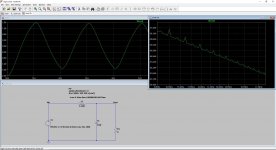
I am not an expert at LTSpice. I only have a very superficial understanding of how it works. So please go ahead and tell me everything I have failed miserably at in a condesending manner. It is easier then testing it yourself on your own computer or pointing it out in way that I could actually learn something from.
Here I have run a 500 Hz square wave through a 12 dB/octave 500 Hz LP filter.
There are harmonics way above the noise floor all the way up to 20 Khz - even though it is low pass filtered. A 500 Hz sinewave does not show any harmonics above the fundamental as expected.
What has linearity, harmony and sustain got to do with it?
I have no idea. Please tell me since it is you that mentioned this here.
No, it was youI have no idea. Please tell me since it is you that mentioned this here.
Very few instruments produce linear sinusoidal wave shapes.
How can all sounds be sinewaves?
From: The nonlinear physics of musical instruments - IOPscience
View attachment 900888
Here I have run a 500 Hz square wave through a 12 dB/octave 500 Hz LP filter.
There are harmonics way above the noise floor all the way up to 20 Khz - even though it is low pass filtered. A 500 Hz sinewave does not show any harmonics above the fundamental as expected.
Can't see anything wrong with this. Of course you see the square wave harmonics above 500Hz because your filter is 12dB/octave, so that is the rate they diminish with rising frequency.
Edit, for those grappling with the duality of time and frequency domain, maybe this pic from Guido Tent may clarify.
Jan
Attachments
Last edited:
When my colleagues start telling me about the distortions of the first period in the simulator, I immediately understand that this colleague has no idea how the simulator works, in particular Microcap. For information: the program counts according to the last period from the burst that we set for analysis. If we set a burst of five periods, then the program will make a test for the 5th period by substituting it multiple times in front and behind so that the signal turns into a periodic one. The program does not pay attention to the phase of the signal, it is important that the period is whole. That's all you need to understand. The program works in the same way for the first period.
Attachments
Jan, you are again avoiding a specific answer. Instead of giving a link to your publication of this amplifier for acquaintance with "how to do", you chatter a request. If this is a commercial development and is not subject to disclosure, say so.I don't understand what you want me to do. Yes, I build that 10MHz 100W amp.
Jan
I thought you had that info already.
LMGTFY:
Winfield Hill's 100W, 10MHz, 1000V/uS AMP-70 | Linear Audio NL
Jan
LMGTFY:
Winfield Hill's 100W, 10MHz, 1000V/uS AMP-70 | Linear Audio NL
Jan
For information: the program counts according to the last period from the burst that we set for analysis. If we set a burst of five periods, then the program will make a test for the 5th period by substituting it multiple times in front and behind so that the signal turns into a periodic one. .
I don't think that is correct. It doesn't substitute anything. If it did, you could never see the evolution of a signal over time.
Jan
- Home
- Amplifiers
- Solid State
- First cycle distortion - Graham, what is that?
